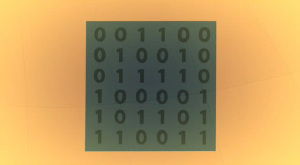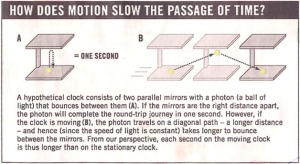In a previous talk, we showed how to predict the mind-bending phenomenon of time-dilation at near-light speeds using basic geometry and algebra. This time, after a review of the setup from Part 1, we will discuss one of the delightfully impossible consequences of faster-than-light travel, namely what Einstein called “telegraphing into the past”. I’d like to acknowledge wikipedia for the example at the end with easy numbers. A couple things to remember before you read: c is the speed of light, v refers to the speed you’re going, x is the position you’re at, and strange things happen at high speeds! This post was adapted from Davis Math Circle lecture notes from February 28, 2015.
How to Measure Distance and Time at High Velocity
Imagine you are riding a bus going at a nice steady speed down the street. You stand at the back of the bus and toss a ball towards the front of the bus. You see the ball moving at, say, 10mph. However, suppose Bob is standing on the sidewalk and looking at the ball. He will see it moving much faster. If the bus is going 25mph, then the ball will appear to go 25+10=35mph. Well, which is it? Is the ball going 10mph or 35mph? Is it white/gold or black/blue? It depends on your frame of reference.

The frame of reference is a much more profound concept than “a point of view” as people often say. If that ball hits Alice on the bus at 10mph, then she will be fine since the ball isn’t going very fast. If the ball left the bus and hit Bob at 35mph, that could be serious! Especially since Bob would probably be too stunned to realize he’s about to be run over by the bus. Notice that if you had thrown the ball towards the back of the bus, Bob would see it going 25-10=15mph.
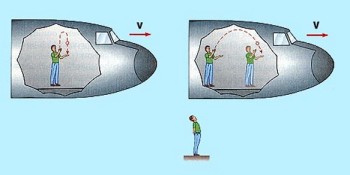
Now, instead of tossing a ball, imagine you stand in the middle of the bus and shine a laser towards the front. Don’t point lasers at people, by the way; just imagine. On the bus, the light will travel at a speed of about 299,792,458 meters per second, or about 670,616,629 mph, and the same if you pointed it towards the back of the bus. (I only say “about” because that is the exact speed of light in a vacuum, by definition. I hope for the sake of your imaginary self that you also imagined that there was air on that bus!)
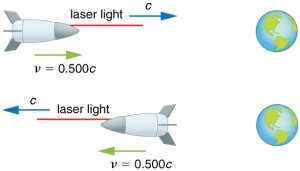
For about 130 years, scientists have very carefully checked that somebody standing on the sidewalk will also see the laser light moving at 299,792,458 meters per second, not 299,792,458 meters per second plus or minus 25mph. Why is light different from balls? I’ll leave that mystery to your physics classes. However, from this simple observation and the Pythagorean theorem, we can derive some of the deepest mathematical formulas you may ever see. (Which is what we did last time. That post will follow when my lecture notes catch up.)
The key concept here is the frame of reference. In Bob’s frame of reference, he is standing still and the bus is going by at 25mph. From your frame of reference, you and the bus are standing still while Bob and the rest of the world goes by in the other direction. Since speeds are being measured so differently, we might also worry that time and distance are being measured differently, too. Outside the bus, Bob uses his tools (a stick and a clock, say) to measure position x and time t, while you use your own tools on the bus to measure x’ and t’.
In the first lecture, we showed that if you’re traveling at speed v, the two systems of coordinates are related by
The first formula is often called time dilation and it implies that Bob will observe your clock running slower than his. The second formula is called Lorentz contraction, named after one of the physicists who proposed these formulas to explain the mysterious Michelson-Morley experiment before Einstein blew everybody away with his new way of thinking about frames of reference, the theory of relativity. Lorentz contraction means that Bob will think your meter stick looks shorter than a meter.
We don’t run into time dilation and Lorentz contraction when riding buses and tossing balls around because that factor is almost exactly 1. Highway speeds are typically under 35 meters per second, and
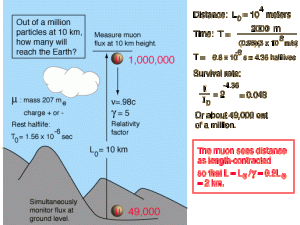
Speeds where this factor does make a noticeable difference are called relativistic speeds. However, since we are flying through space with nothing but a comically thin layer of gas and a magnetic field between us and a big universe full of constantly exploding nuclear fusion reactors, we do get bombarded by radioactive particles for whom these formulas make quite a significant difference. In the first lecture, we talked in detail about the case of the muon, the electron’s fat cousin.
Energy
In today’s Math Circle, we will use the Lorentz transformations to play around with what would happen if we could text each other faster than the speed of light. This sounds somewhat innocent, but every rational thing you hold dear completely falls apart. First, let’s write down one more formula from Einstein:

We’ve all seen the famous formula a million times, so what is this thing? The formula
applies to something that is not moving. Which is incredible because it implies that all matter has innate potential energy. Once something gets moving, it has kinetic energy. In the slow world of busses and balls, the kinetic energy from movement, is
. At higher velocities, the formula above is much more accurate.
Exercise: For those of you who have seen derivatives or Newton’s binomial theorem, can you show that for v much smaller than c?.
Let’s focus on that term that keeps popping up. Remember that it came from the Pythagorean theorem in our derivation last time. What happens as v gets close to c? Well, v/c gets close to 1, so
gets close to 0. If we are dividing by a number close to zero, that is the same as multiplying by a huge number! That means that anything trying to move at speeds closer and closer to the speed of light will need more and more energy. To reach the speed of light or exceed it would take an infinite amount of energy! So, everything around us, no matter how hard we push it, will never go as fast as the speed of light.

Well… except for that one thing. Light! Why does light get to go so fast? Well, there’s a nice work-around in Einstein’s formula: just set the mass to 0, and you can go light-speed without any trouble. Could there be a such work-around for faster than light travel?
Tachyons
If you’ve consumed much science fiction, then you’ve probably run across the word “tachyon” before. Particle names end in “-on” like proton, electron, gluon, etc. What does “tachy-” mean? Fast! By the way, the “ch” is like the “ch” in “Chris”, not “nacho” or “machine”. Tachyons are theoretical fast particles that would move at speeds beyond that of light, a.k.a. superluminal.
But wait! Didn’t we just say it was impossible to make something go from below the speed of light to above it? Yes… any future lawyers or logicians amongst you? What if the object never went slower than the speed of light? What if it came into existence already at higher speeds? Well, then we call it a tachyon. Let’s look at some of their wacky properties.
Since ,
and
. Do you see the weirdness? The energy of a tachyon would be
an imaginary number! But we don’t want that. If it’s going 400,000,000 meters per second, it should have some amount of energy that would be measurable. How can we fix this? Well, you might not think this is much better, but we could assume that it has imaginary mass, . That way, the
would cancel, and we’d be back to a real energy. Perhaps even an energy that’s small enough to produce such particles in a particle accelerator!
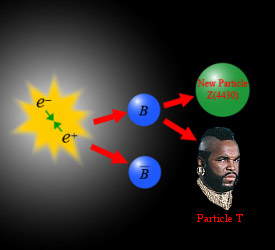
Ok, tachyons are theoretical particles with imaginary mass that move faster than the speed of light. Got it? In that case, it takes an infinite amount of energy to slow them down to light speed.
All of this so far is exotic, but not necessarily impossible. To the impossible!
Tachyonic Texting
Suppose that Alice and Bob have communication devices that use tachyons. This allows them to communicate faster than the speed of light, say at speed . Suppose Alice is at position A and Bob at position B, both in the same reference frame. Alice sends a signal at time
and Bob receives it at time
. Then the time it took was
since distance over speed is time.
That all seems perfectly ordinary and boring. But now, suppose you are flying by in a space ship going at relativistic speeds. In your reference frame, the time it takes the signal to go from Alice to Bo is
Ok… a lot of algebra happens. So what? Well, if you’re moving fast enough so that , which is possible since
, then you would see Bob get the message before Alice sends it!!

Exercise: Get a feel for how much of an effect this is by plugging in different values for a, v, and .
Two-Way Example
Now let’s figure out what happens from Alice’s perspective if she messages Bob at superluminal speed and then gets a superluminal message back while traveling at relativistic speed. To make the formulas a little simpler, let’s measure time in seconds and distance in light-seconds so that . We also use the standard shorthand of writing
(That is the Greek letter gamma, the equivalent of a lower-case g.)
Suppose Alice is moving away from Bob at speed . She sends Bob a tachyonic text with speed
, then Bob immediately texts back with the same kind of device when he gets the message.
Alice’s reference frame: She stays at position . Her message travels a distance
.
Bob’s reference frame: He remains at position , and his reply will be at
since the distance it travels is
.
Alice’s reference frame: The reply signal is at
So, if , then
and
The time it took the message to get to Bob was , so the total time
elapsed between when Alice sends the message and when Alice receives the message is
Exercise: Show for yourself that if then

Two-Way Example with Numbers
Let’s try a scenario where Alice sends a message to Bob, then Bob replies. To keep things concrete, we’ll use particular numbers. Let’s measure time in units of days, distance in units of light-days. Once again, this has the nice bonus consequence of in these units.
Suppose Alice and Bob are each in their own spaceship traveling at a relative velocity of . When they pass each other, they synchronize their clocks and set that position to 0.
Alice’s reference frame: Alice stays at while Bob moves along
.
Bob’s reference frame: Bob stays at while Alice moves along
.
Alice’s reference frame: After 300 days (), Alice sends a message at speed 2.4 to Bob, “I should have played 7 49 53 60 64 4 in the MegaMillions Lottery yesterday!” Then, 150 days later (
), the signal is at position
light-days. Bob’s position is
light-days. So, in Alice’s reference frame, Bob gets the message at
.
Bob’s reference frame: We can compute that , so Bob receives the message at
due to time dilation. He then immediately replies, “Play 7 49 53 60 64 4 in the MegaMillions when
!” In his frame, 135 days later, Alice’s position is now
. The position of the signal is
, so that is where/when Bob thinks Alice gets the message.
Alice’s reference frame: Here, we also have that , so Alice receives the message at
. Almost two months before the lottery at
! Small snag: if she wins the lottery, why would she send the message? But then how did she win the lottery? What does it mean for one event to come before or after another one? I guess it could be worse:

Go ahead and calculate when Alice would receive a reply if she replied to the lotto numbers message. And if they did it again? Can you find a way for Alice to get a message before she ever even meets Bob? Play around with some other numbers. To get nice numbers like I did, use speeds that are multiples of one another, and a that gives a Pythagorean triple in order to get a nice
.
Exercise: Pictured below is the Time Code found on the mysterious tattoo that appeared on Fry’s butt which allows for time travel. Can you see where the writers got these particular binary strings?
